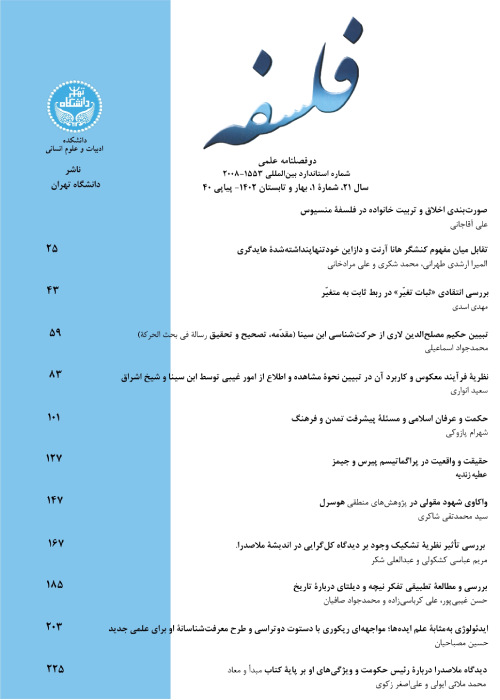Ḥakīm Muṣliḥ al-Dīn Lārī's Explanation of Avicenna's View on Motion An Analytical Introduction and the Editio Princeps of the Treatise on the Discussion of the Motion
Author(s):
Article Type:
Research/Original Article (دارای رتبه معتبر)
Abstract:
Ḥakīm Muṣliḥ al-Dīn Lārī (979/80 AH/ 1572 CE) was a 10th AH/16th Century AD philosopher and historian. His extensive travels across the Safavid realms in Iran, the Gurkan domains in India, and the Ottoman territories in Asia Minor provided him with a profound cross-cultural perspective, deeply influencing his philosophical thought. As for the Life of Ḥakīm Lārī, a paucity of extensive biographical information has confined contemporary research to a scant collection of extant writings. Born in the southern city of Lār in 890 AH/1510 CE, Lārī's contributions to philosophy, astronomy, and history are noteworthy. This cross-cultural experience profoundly impacted his philosophical thought, as evidenced in his writings. Lārī's intellectual formation was shaped by the teachings of Ghiyāth al-Dīn Manṣūr Dashtakī (948 AH/1541 CE), son of Sayyid Ṣadr-al-Dīn Dashtakī (903 AH/1498 CE), and Kamāl al-Dīn Lārī (10th Century AH/16th Century CE), a student of Jalāl al-Dīn Davānī. One of Lārī's notable works, the The Paradigm of the Sciences (Unmūdhaj al-ʿulūm), has been identified in two complete manuscripts in two Turkish libraries. Additionally, three copies of an excerpt from this work, titled "on the Discussion of the Motion" (fī bahth al-ḥaraka), are preserved in libraries across Iran, Germany, and Turkey. His "on the Discussion of the Motion" is the twelfth part of the treatise The Paradigm of the Sciences, a comprehensive work encompassing both rational and traditional sciences, organized into twenty-one discussions. Lārī's critical approach in this work imbues it with enduring philosophical value. He engaged with the thoughts of prominent thinkers across the ages, including Aristotle (322 BCE), Fārābī (339 AH/ 950 CE), Avicenna (428 AH/1037 CE), Suhrawardī (587 AH/ 1191 CE), Qūshchī (878 AH/1474 CE), and Davānī (908 AH/ 1502 CE). In this work, Lārī establishes himself as a peer to Davānī through a philosophical dialogue with his criticisms. This work is concerned with a definition of motion, the elements of defining motion and the intimate relationship of motion to time. It examines the fluid nature of the present now (flowing now), the distinction between finite and infinite entities, and two meanings of motion: instantaneous (ḥaraka tawassuṭiyya) and continuous (ḥaraka qaṭ'iyya). It also explores a particular kind of motion in a category, including motion in quantity, condensation, and growth. The connectedness of the unit and the notion of a natural unit are carefully examined, as are the nature of a physical body, the singularity of a certain thing, and the notion of an individual entity. The methodology employed in editing the text adhered to the following principles: precedence of date, textual completeness, lexical and philosophical aspects, Modern Standard Arabic readability, Middle Arabic variants, and elimination of unnecessary orthographic differences. This approach ensured that the text's integrity was preserved while enhancing its accessibility to a modern audience.
Keywords:
Language:
Persian
Published:
Philosophy, Volume:51 Issue: 1, 2023
Pages:
59 to 82
magiran.com/p2701771
دانلود و مطالعه متن این مقاله با یکی از روشهای زیر امکان پذیر است:
اشتراک شخصی
با عضویت و پرداخت آنلاین حق اشتراک یکساله به مبلغ 1,390,000ريال میتوانید 70 عنوان مطلب دانلود کنید!
اشتراک سازمانی
به کتابخانه دانشگاه یا محل کار خود پیشنهاد کنید تا اشتراک سازمانی این پایگاه را برای دسترسی نامحدود همه کاربران به متن مطالب تهیه نمایند!
توجه!
- حق عضویت دریافتی صرف حمایت از نشریات عضو و نگهداری، تکمیل و توسعه مگیران میشود.
- پرداخت حق اشتراک و دانلود مقالات اجازه بازنشر آن در سایر رسانههای چاپی و دیجیتال را به کاربر نمیدهد.
In order to view content subscription is required
Personal subscription
Subscribe magiran.com for 70 € euros via PayPal and download 70 articles during a year.
Organization subscription
Please contact us to subscribe your university or library for unlimited access!


